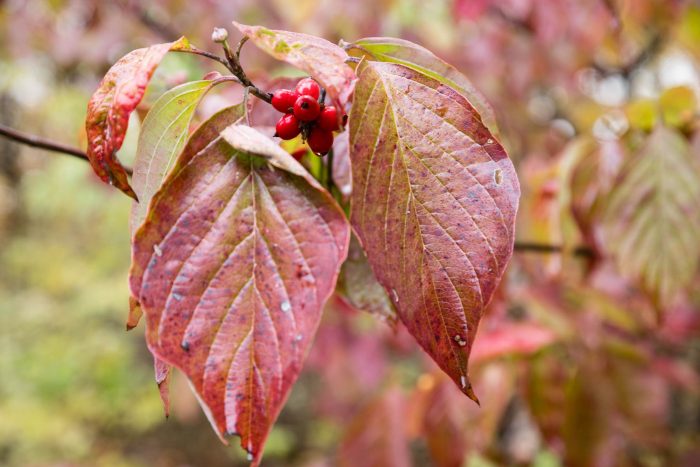Flowering Dogwood
Cornus florida
Flowering dogwoods are an understory tree that provide year-round interest with spring flowers and fall fruit.
This section shows one large critter image at a time. Use the thumbnails that follow to select a specific image to display here.

This gallery contains a grid of small thumbnails. Selecting a thumbnail will change the main image in the preceding section.
Appearance
Flowering dogwoods are a branching tree. The reddish-brown bark is deeply grooved with raised bumps and is often compared to alligator skin. Each spring, the tree develops flowers surrounded by three-inch white or light pink bracts. The tree then produces half-inch fruits that will turn red by late summer.
Predators
Flowering dogwoods tend to be resilient trees, but if placed in environments that create stress, they can fall prey to insects and diseases. The dogwood borer larvae will feed on the trunks of the tree, which can kill the entire tree. Dogwood club-gall midges will cause some twigs to swell and create deformed leaves. They usually aren’t a significant problem, but a heavy club-gall midge infestation will stunt the growth of a tree. Dogwoods are also susceptible to a wide range of diseases. The most significant issue is dogwood anthracnose, a large problem in the eastern United States.
Reproduction and life cycle
Dogwoods bloom in spring. The trees have many small, yellow flower clusters. Each cluster is surrounded by four white or light-pink bracts, or modified leaves. People often think of the bracts as flower petals. Flowering time ranges from mid-March to mid-May. The tree forms fruits known as drupes that turn bright red by late summer. Each drupe contains two seeds. The seeds usually sprout the following spring.
Did you know?
- The flowering dogwood is the host plant of the Spring Azure (Celastrina ladon) butterfly.
- The dogwood is the state tree of Virginia and Missouri.
- American Indians used many parts of the tree to treat various ailments. Early European immigrants drank tea brewed from the bark to treat fevers. The fruit are now believed to be poisonous to humans.
- The wood is shock-resistant and has been used for weaving supplies, pulleys, mallets, chisels and golf club heads.
- 36 species of birds, including ruffed grouse, bobwhite quail and wild turkey, eat the fruit. The
Sources and additional information
- Arbor Day Tree Guide: Cornus florida
- United State Department of Agriculture Natural Resources Conservation Center: Flowering Dogwood
- United States Forest Service: Flowering Dogwood
